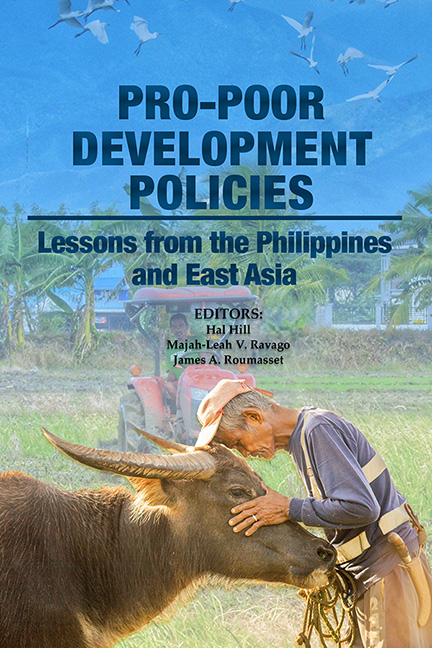Book contents
- Frontmatter
- Dedication
- Contents
- Figures, Tables and Boxes
- Foreword
- Foreword
- Message
- Preface and Acknowledgements
- About the Editors
- About the Contributors
- Acronyms
- Part 1 Introduction and Synthesis
- Part 2 Agricultural and Economic Development
- Part 3 Economic Policies for Achieving Targeted Levels of Living in the Philippines
- Part 4 Inequality and Economic Development
- Part 5 Competition Law and Policy
- Part 6 International Dimensions
- Index
15 - Convergence of Philippine Spatial Inequality during the American Colonial Period
Published online by Cambridge University Press: 09 January 2024
- Frontmatter
- Dedication
- Contents
- Figures, Tables and Boxes
- Foreword
- Foreword
- Message
- Preface and Acknowledgements
- About the Editors
- About the Contributors
- Acronyms
- Part 1 Introduction and Synthesis
- Part 2 Agricultural and Economic Development
- Part 3 Economic Policies for Achieving Targeted Levels of Living in the Philippines
- Part 4 Inequality and Economic Development
- Part 5 Competition Law and Policy
- Part 6 International Dimensions
- Index
Summary
INTRODUCTION
This paper explores spatial inequality in the Philippines during the American colonial period. Although there is sizable literature on regional development and dynamics in the Philippines in the late twentieth century (see Balisacan and Hill 2007; Estudillo 1997), comparatively little has been said about the economic and development disparities across regions in the early twentieth century, and how these disparities may have been shaped during the American colonial rule.
The Philippines was a country in shambles at the beginning of the twentieth century. Engaged in sporadic battles since the Revolution of 1896 and eventually declaring independence from Spain in 1898, the country found itself confronting yet another emerging empire, the United States. In 1898, just months after Spain ceded the Philippines to America via the Treaty of Paris, the nascent Philippine Republic waged war against its new colonial master. The atrocities inflicted on the population were staggering: the US army corralled men, women and children in Laguna and Batangas—about 300,000 of them—in concentration camps and razed houses, farms and livestock. The economic dislocation proved to be so widespread, it would take several decades for the country to recover (Corpuz 1997). The conflict also exacted a tremendous toll on human development, from which the Philippines took decades to recover. For instance, Bassino, Dovis, and Komlos (2018) find that Filipinos’ heights in the 1930s (a proxy for nutrition adequacy) took 60 years to recover from levels recorded back in the 1870s.
After quelling the armed resistance as well as co-opting Filipino elites by its “policy of attraction”, America embarked on an ambitious project to prepare Filipinos towards independence and self-government. This entailed building institutions such as the civil service, public infrastructure and economic policies for the “prosperity and contentment to the country of the Philippines” (Corpuz 1997). The thinking was that a dynamic Philippine economy, serving as “a ready and attractive field of enterprise”, will not be a burden to the American people (Booth 2012; Corpuz 1997).
As a result of this deliberate policy, and partly because the economy was coming from a low base, the country’s gross domestic product (GDP) grew by an average annual rate of 5.2 per cent from 1902 to 1910 and 5.79 per cent from 1910 to 1920.
- Type
- Chapter
- Information
- Pro-poor Development PoliciesLessons from the Philippines and East Asia, pp. 390 - 413Publisher: ISEAS–Yusof Ishak InstitutePrint publication year: 2022



